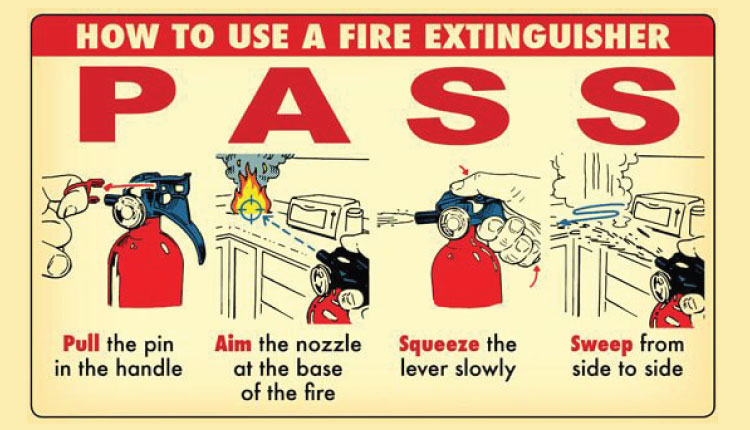Fire extinguishers are an extremely effective tool for fighting fires, but only if you know how to
use them properly! Here we offer some useful tips and reminders for their safe use – and what
to avoid.
There really is no substitute for hands-on training, so if you really want to be confident, take the
opportunity of doing a hand-held fire extinguisher training course.
If in doubt, get out!
When considering whether to tackle a small fire yourself, always bear in mind the golden rule of
fire safety.
If in doubt, get out, stay out, and call the Fire Brigade out!
Using a Fire Extinguisher on ClassA, B or C Fire
These fires are the most common that you might be required to deal with. Most water, foam,
CO2, and powder fire extinguishers work in the same way, regardless of shape or size. An easy
way to remember what to do when operating a fire extinguisher is to think of the acronym PASS.
- Pull the safety pin out, to free the lever on top of the extinguisher
- Aim the fire extinguisher nozzle or hose at the base of the re,standing around 8 feet
back from the fire - Squeeze the handle evenly to release the re-fighting agent
- Sweep the nozzle or hose across the base of the fire (not the flames) until it is fully extinguished.
Using a Fire Extinguisher On or Near Electrical Equipment
Only use a fire extinguisher on or near electrical equipment if the extinguisher carries the electrical safety icon – a lightning flash with an arrow. These are normally found on CO2, dry powder and clean agents such as FE-36 and FM200.
The best fire extinguisher to use safety and directly on live electrical equipment is a CO2 fire extinguisher. Using a CO2 Fire Extinguisher When using CO2 fire extinguishers with a ‘swivel horn’, be careful not to hold the extinguisher by the horn. As the CO2 is released, ice rapidly forms on the horn and your skin may get frozen and burnt as a result.
Note:
Many new 2kg CO2 extinguishers feature a ‘frost-free’ horn that should be safe to hold. However, it will not be obvious to most operators which models are safe and which are not, so we recommend you don’t hold the horn at all.
Larger CO2 fire extinguishers should have a hose and horn. You can safely hold this horn by its plastic handle or by the base of the horn that joins on to
Tackling a Class F Cooking Oil or Cooking Fat Fire
Class F fires involving cooking oils and fats should only be tackled using a suitably sized fire blanket (1.8m x 1.2m) if the fire is small and confined to a pan or cooker top.
If the fire is large, then a wet chemical fire extinguisher would normally be required, however, these need special training to be used effectively.
Never use water, foam or CO2 on Class F cooking oil or cooking fat fire, as these will only cause the fire to explode and spread every quickly.
Using a Metal Fire Extinguisher on a Class D Fire
Class D fires involving flammable metals require specialist fire extinguishers and fire extinguishing materials which have a special lance and low-velocity applicator.
You should always be given full training in the use of these specialized extinguishers.
More Useful Health & Safety Topics.
- First Aid Treatment For Electric Shock
- First Aid for Common Childhood Injuries
- How Should A Noise Assessment Be Done?
- Top 10 Rules for Kids About Electrical Safety
- 10 General Safety Rules You Should Teach Your Children
- How Do Fire Sprinklers Work?
- 11 Requirements To Become a fighter.
